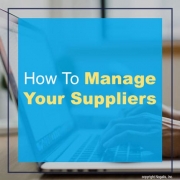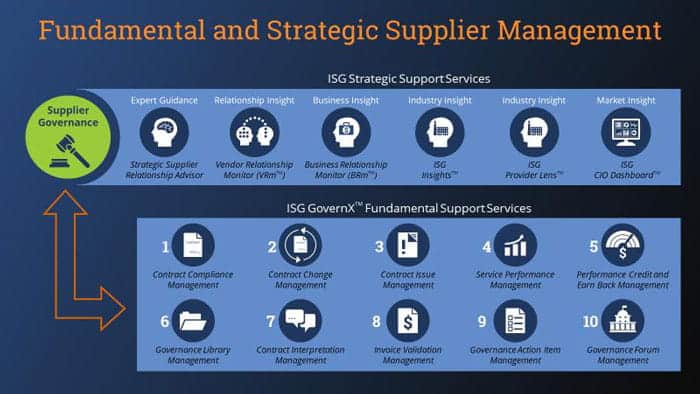How To Manage Your Suppliers
Against this background, rewards should function as expectation. Thinking through the worst-case scenario is important, but provided the supplier exceeds your expectations, he should be rewarded for what he has done. This can be an instant payment or a simple thank you. [Sources: 0]
Both the customer and the supplier are responsible for the success or failure of the working relationship. Take responsibility for your place in the process and acknowledge that your decisions about delays, timing or changes in project scope can affect the ability of suppliers to do their job. Maintain your sanity and the sanity of your office manager. [Sources: 0]
By sharing the results of this analysis with your suppliers, you can develop a more accurate sales plan and work on a common sales forecast and planning. The use of an ordering system to control and monitor the purchase of goods and services from suppliers can be used to facilitate internal financial control and to avoid specification misunderstandings with suppliers in the end. You should also have a payment policy that requires your company to pay undisputed invoices on time, with copies sent to your suppliers. This puts a strain on your relationship with suppliers, but can also lead to more favorable conditions in the future. See our Guide to Storage and Control of Stock. [Sources: 9]
When you talk to purchasers and quality teams, one of their main obstacles to good supplier management is supplier information management – the constant maintenance of information. Make sure that the platform you choose allows providers to update their own information systems so that it is easy for them to do so. In this way, they are responsible for maintaining up-to-date information, which is important for all suppliers. For example, set notifications and reminders for vendors whose certificates have expired so they can make a new copy, rather than having to chase them. [Sources: 4]
The supplier management process does not end when you have chosen a supplier. After selecting and entering, you will need to evaluate their performance to see if they meet a range of objectives and requirements. To ensure a practical evaluation, make sure you create KPIs to measure performance. [Sources: 3]
The following chart shows the basic strategic levels that are necessary to effectively manage suppliers. The execution of basic activities in connection with complex supplier relationships is computationally intensive and expensive. When a company merges data from daily supplier management with data from the broader industry, the company, its vendors and the market, it draws a detailed picture of the source relationships and their potential for improvement. [Sources: 1]
The responsibility for supplier relationship management lies solely with the procurement team. Strategies for managing supplier relationships are craftsmanship and can never be achieved without involving internal stakeholders. One villain can bring down the entire process. [Sources: 5]
Here are five ways to improve strategic supplier relationships. One of the most overlooked aspects of strategic supplier relationship management is how suppliers are viewed by the purchasing organization. When an SRM considers the entire supply base, strategic suppliers are seen as part of the whole. [Sources: 8]
Strategic suppliers, be it strategic issues or cross-functional concerns. Therefore, buyers should be careful to bring their stakeholders together and involve them in the management of the partnership. Companies should invite relevant employees to supplier meetings to discuss performance and future opportunities. [Sources: 8]
GM should have a formal system for suppliers to provide it with feedback. Assessment procedures should not be a one-way street. GM cannot be expected to build trust without listening to its suppliers. What we need is to pool resources for joint projects and reassure suppliers that GM is committed to their success. [Sources: 2]
Be sure to maintain strong and regular communication with your suppliers. If something doesn’t work for you, let them know. Keep them informed of your strategy and plans so they know where they fit in, how they can help with the plan, and who benefits. If you appreciate their work, let your suppliers know. [Sources: 7]
Your suppliers play a big role in your retail business, so don’t neglect them. Strive to find the best providers in your industry, and once you have an agreement, maintain a healthy relationship through communication, professionalism, and good old-fashioned kindness. [Sources: 6]
Procurement officials need to research carefully to maintain beneficial relationships with suppliers, not counterproductive showdowns. Poor quality can be expensive, so procurement officials should be more careful in selecting suppliers and learn more about the suppliers they want to know. [Sources: 2]
Globalization has torn today’s businesses apart and made business processes more dynamic, competitive and complex than ever before. Organizations engage suppliers to provide various goods and services to maximize business performance. Suppliers are an indispensable part of any business and their effective management is crucial. [Sources: 3]
For many organizations, SRM is seen as a tool to manage critical suppliers. In a previous paper, I examined the SRM framework. In researching the entire supply chain, I segmented strategy and supplier initiatives by segment. [Sources: 8]
Expenditure management and visibility: not having SRM on board means missing data and poor visibility of expenditure. If you do not know how much is spent on a seller or what is bought in detail, it is impossible to judge whether you are getting the best service value and it is difficult to compare providers. [Sources: 7]
If you have a Service Level Agreement (SLA), it will help you to assess the relationship between companies and suppliers as objectively as possible. Not all levels are the same, but it is worth using an SLA to define the level of service you require from your suppliers. [Sources: 9]
Sources:
[0]: https://quickbooks.intuit.com/r/products-and-manufacturing/10-tips-to-effectively-manage-vendors-and-suppliers/
[1]: https://isg-one.com/third-party-management/isg-governx-spend-management/articles/top-ten-fundamentals-for-managing-suppliers-a-checklist
[2]: https://hbr.org/1989/07/managing-suppliers-up-to-speed
[3]: https://www.zycus.com/blog/supplier-management/understanding-supplier-management-its-benefits-process-and-best-practices.html
[4]: https://spendmatters.com/2019/10/17/5-easy-steps-to-better-manage-your-suppliers/
[5]: https://kissflow.com/procurement/vendor-management/supplier-relationship-management/
[6]: https://www.vendhq.com/blog/supplier-relationship-management/
[7]: https://planergy.com/blog/improve-supplier-relationship-management/
[8]: https://www.forbes.com/sites/jwebb/2018/03/30/how-to-manage-strategic-suppliers/
[9]: https://www.infoentrepreneurs.org/en/guides/manage-your-suppliers/



